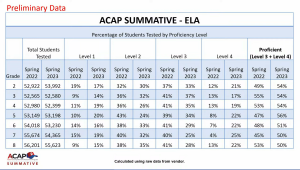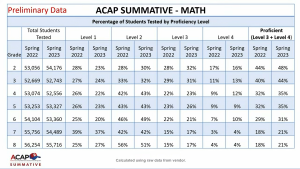Recapping important State Board of Education policy decisions for you
Here are our key takeaways from the July 11th State Board of Education meeting and work session – and what they mean for Alabama’s students. Also, congratulations to Mrs. Tracie West for being elected as the new Vice President of the Board and to Dr. Tonya Chestnut for being elected as the new President Pro Tempore of the Board!
Top 4 Key Takeaways
1. Takeaways from Preliminary 2023 State Assessment Results
Last month, the Board received the data on the reading subtest of the ACAP exam administered this spring. This month, the Board received the preliminary data on the entirety of ACAP exam scores, as well as ACT, ACT WorkKeys, and ACCESS for ELL students.
As a state, Alabama is showing modest but important progress on ACT, ACAP summative, ACT WorkKeys, and the ACCESS assessment results. Notably, math scores on the ACAP Summative increased by 2-4% in every grade level, with the largest increases at four percent in second and third grade. Scores on the ELA Summative exam increased in every grade except third and eighth. (As a reminder, this year’s third grade students had sporadic in-person education in Kindergarten and first grade due to the COVID-19 pandemic.) The largest increases in ELA were at five percent in second and seventh grade, and at nine percent in fifth grade.


ACAP Alternate, the assessment used to measure learning for special education students, is in need of improvement, especially in math and ELA. You can see the presentation with all preliminary results here. Dr. Mackey informed the Board that districts are currently reviewing results, and final data will be available to the public July 31.
2. Literacy Act Implementation Discussion
During the work session, questions from Board members were submitted to Dr. Mackey about how many students would have been impacted by the Alabama Literacy Act’s requirement that students not reading on grade level by the end of the 3rd grade be retained. Of this year’s third grade students, 12,843 students would have been in jeopardy of being retained if that part law were in place. Of current second grade students, 11,636 are in danger of being held back next school year when the retention component is active.
Families of those second graders scoring below proficiency have been notified of summer reading camps available to them this summer. Next steps include the creation of reading portfolios that can also be used to determine whether a student meets the ten minimum standards required for promotion to fourth grade. There will also be use of good cause exemptions for certain students, including special education and certain English language learners. Overall, Dr. Mackey suggested that there would be about 4,000-5,000 students that would actually be retained next year.
Dr. Chestnut commended work in Wilcox county during the conversation. Community leaders came together to train facilitators from the community, who are being paid to learn how to support and assist parents as they help their students learn to read. Facilitators are using family resources from ARI to help parents learn about the science of reading. Dr. Chestnut hopes to replicate this model in other communities in her district, and other Board members expressed an interest in learning about how the program works.
3. Legislative Updates from the 2023 Regular Session
The Board received an update from its Government Affairs team on the 2023 Regular Legislative Session, including the bills that passed and how they affect the Board. The update highlighted the changes in the Education Trust Fund, new legislation (e.g. the School Principal Leadership and Mentoring Act), and changes to previously passed legislation (updates to the Charter Law, the Alabama Accountability Act, and the Alabama Literacy Act). Click here to read our full session recap and click here to see our ETF budget summary.
4. Governor’s Turnaround School Initiative Update
Office of School Improvement Coordinator AJ Buckner presented on the status of the Governor’s Turnaround School Initiative. Fifteen schools in various districts across the state were chosen to be part of the initiative due to their persistently low performance (Comprehensive Support and Improvement schools, etc.). In early signs of progress, 10 of the 15 turnaround schools were removed from the CSI, ATSI, Failing schools list, or multiple lists.
In the work session, Dr. Richardson asked what would be done to ensure that schools removed from those lists would stay off. The work will continue with these schools to ensure that they keep growing and don’t get back on any struggling school lists.
5. Federal Programs & Special Education Updates
In September 2022, the Board received an update on an overhaul of special education services at the state level. The ALSDE received $38 million in additional funding through federal ARP ESSER funding to expand support for students with disabilities, who are 17.8% of students as of the 2021-2022 school year.
Dr. Mackey announced in his superintendent’s report during the special education IDEA review, Alabama has met all the requirements of IDEA (the federal Individuals with Disabilities Education Act, which governs special education services). In addition, Alabama was the only state to have no errors in the audit of ESSER I funding.
To see the full July Board Meeting and Work Session agendas, click here.
The Alabama State Board of Education usually meets on the second Thursday of each month, with the exception of the July meeting, to discuss important policies, procedures, and changes for Alabama’s K-12 public schools. The Board takes official action during their monthly meeting and then follows up with a Work Session to get updates and discuss future action that will be voted on at the next board meeting. You can watch them live and see old meetings here.
Contact Your Board Member:
Have feedback on any of the above items – or anything else? Contact your state school board member using the resources below:
-To contact your State Board of Education Member, click here.
-To find out which district you live and/or teach in, click here. Scroll down to the bottom of the page and enter your address in the “Polling Place Search” box. Once entered, it will take you to a page that shows your polling place and the districts you live in.
-To view a map of the state school board districts, click here.

0 Comments on "Across the Board July 2023: Key Takeaways from the ALBOE Meeting"